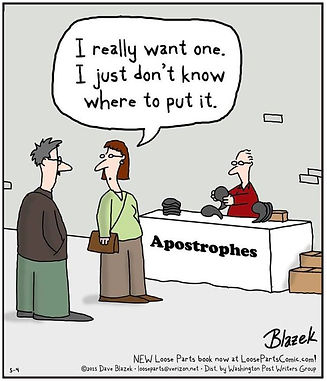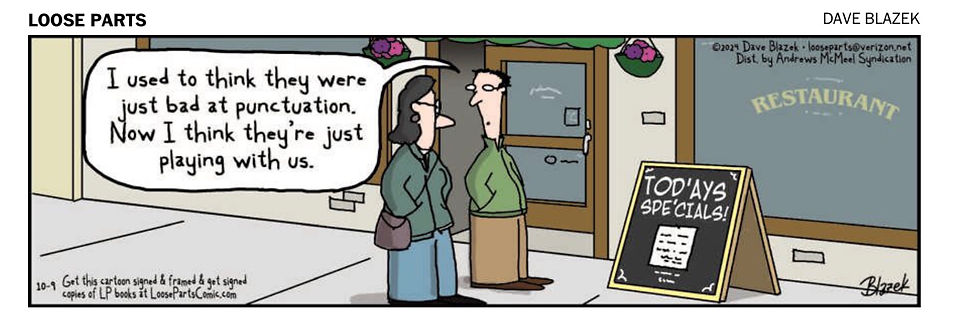
Apostrophe Protection Society
The Correct Use of the Apostrophe in the English Language
The apostrophe is one of the most misused punctuation marks in English, yet its rules are simple once understood. This page explains the correct use of apostrophes, and highlights some of the most common mistakes, such as confusing plurals with possessives. Whether you are a student, teacher, or simply someone who wants to write more accurately, this guide will help you use the apostrophe with confidence.

1. To denote missing letters – omission or contractions
The apostrophe is used to show that one or more letters have been omitted from the word, or that multiple words have been contracted:
-
I can’t instead of I cannot
-
I don’t instead of I do not
-
it’s instead of it is or it has
There are a few examples that have more than one separate omission:
-
Fo’c’s’le – contracted from the nautical term “forecastle”
2. To denote possession or association
For singular nouns, the standard approach is to add an apostrophe and "s":
-
the dog’s bone
-
the company’s logo
-
the boy's bike
If there are two or more dogs, companies or boys in our examples, the apostrophe comes after the 's':
-
the dogs’ bones
-
the companies’ logos
-
the boys' bikes
-
the Joneses' house (plural of the name Jones takes an "es" and is therefore Joneses)
But be careful about possessives of plural nouns that don't end in "s".
These possessives are formed with an apostrophe and "s" - do not make them incorrect by adding "s" then the apostrophe:
-
the children's bicycles (not the childrens' bicycles)
-
the men's clothing department
Acronyms and initialisms follow the same rule:
-
NATO’s defence policy
-
The TV’s picture quality
Possessives of people's names
Most names follow these same rules. Names that don't end in an "s" add an apostrophe and "s":
-
Shakespeare's plays
-
Peter's dog
-
Anna's bicycle
When the name ends in an "s", you either add an apostrophe and "s" or just an apostrophe. The choice depends on the style guide that you're following and, to some extent, the country in which you live. Thus:
-
James's pen or James' pen
-
Mr Jones's van or Mr Jones' van
-
Jesus's disciples or Jesus' disciples
-
Keats's poems or Keats' poems
Some guides say that we only add an apostrophe and "s" if the possessive form is pronounced with an extra "s" sound.
Generally, most guides prefer the apostrophe-s style.
3. In temporal (time) expressions
These denote periods of time, either singular or plural:
-
One week’s notice
-
Two weeks’ holiday
4. Possessive pronouns and possessive adjectives
Possessive pronouns and possessive adjectives are two types of words that show ownership or belonging. They have different functions and positions in sentences. They don't need apostrophes!
Possessive adjectives are words like my, your, his, her, its, our, and their. They go before a noun to modify it and indicate who or what it belongs to. For example:
-
This is my book.
-
She likes your shirt.
-
They live in their house.
Possessive pronouns are words like mine, yours, his, hers, ours, and theirs. They replace a noun or a noun phrase and stand alone. They do not need a noun after them. For example:
-
This book is mine.
-
I like your shirt. Is it yours?
-
Their house is big. Ours is small.
Both possessive pronouns and possessive adjectives agree with the possessor, not the possessed. For example:
-
He lost his keys. (His agrees with he, not keys.)
-
She loves her dog. (Her agrees with she, not dog.)
A common mistake is to confuse the possessive adjective its with the contraction it’s, which means it is or it has. Remember that possessive adjectives do not have an apostrophe. For example:
-
The cat licked its paw. (Correct)
-
The cat licked it’s paw. (Wrong)
5. Special mention for “its” and “your”
This use, and misuse, of “its” and “it’s” can cause particular excitement amongst apostrophe pedants! The distinction is simple:
It’s – is a contraction of “it is” or “it has”, and uses an apostrophe to show that contraction:
-
It’s important to get this right
Its – is a possessive personal pronoun (like “our”, “his”, etc) indicating ownership, or possession, or association of something, and does not take an apostrophe:
-
The dog ate its bone and we ate our dinner
If you’re unsure whether you need “it’s” with an apostrophe, just expand out the contraction to “it is” or “it has”, and see if it makes sense:
-
“The dog ate it is bone” - doesn’t make sense, and is incorrect.
Note that there is never a valid use for having the apostrophe after the “its” – thus its’ is always wrong.
The distinction between “you’re” and “your” is very similar:
You’re – is a contraction for “you are”, and therefore takes an apostrophe:
-
You’re coming over to my house
Your – is possessive (like "my" or "his"), and doesn’t take an apostrophe:
-
this is your pen
Again, if it doubt, expand out the contracted form to “you are” and see if it then makes sense:
-
You are coming over to my house – makes sense
-
This is you are pen – doesn’t make sense, and is wrong.
6. Apostrophes are NEVER used to denote plurals!
It's a simple rule - do not make a plural by using an apostrophe and "s"!
-
Banana’s for sale which of course should read Bananas for sale
-
Menu’s printed to order which should read Menus printed to order
-
MOT’s at this garage which should read MOTs at this garage
-
1000’s of bargains here! which should read 1000s of bargains here!
-
New CD’s just in! which should read New CDs just in!
Plurals of single lowercase letters are possibly an acceptable exception to the rule for the purpose of clarity and to avoid ambiguous interpretation – thus “minding your p’s and q’s”. For plurals of single uppercase letters, there is less scope for ambiguity or confusion, so “He achieved 3 As and 4 Bs” is clear enough without any apostrophes.
Finally, when expressing a decade, an apostrophe is used to denote omission, but not a plural - e.g. the ’60s, compared with
the 1960s (not the 1960’s).
7. Attributive nouns and apostrophes
In English grammar, an attributive noun is a noun that modifies another noun and functions as an adjective. Most examples of this involve a singular attributive noun - for example, "a government official", "a bottle opener", "business ethics".
However, when the first noun in a compound pair is plural, it can become difficult to decide whether the first noun is acting as a noun that ought to be showing possession, or as an attributive noun acting as an adjective.
Consider the case of the noun pair "farmers market ". The use of an apostrophe in a phrase such as this can be a topic of debate, as it depends on how the phrase is intended to be used and understood. In this specific case, the term is generally used as a noun to refer to a type of market where farmers sell their products directly to consumers. In this context, the phrase does not show possession and therefore does not require an apostrophe.
However, if the phrase is being used in a more possessive sense, such as "the farmers’ market", then an apostrophe would be necessary to indicate possession. In this case, the apostrophe would show that the market belongs to the farmers, rather than just being a market for them to sell their products. If it was only one farmer, then it would be "a farmer’s market".
Ultimately, whether an apostrophe is needed in a word pair like "farmers market" depends on the context and intended meaning of the phrase. In most cases, however, the phrase is used as in a descriptive way and does not require an apostrophe.
It is always important to consider the context and intended meaning when using apostrophes, as they can greatly affect the meaning of a phrase. Remember also that different style guides will differ on this, so it may be necessary to refer to any preferred style guide when unsure about the use of apostrophes with compound nouns.
8. Double Genitive - is it "a friend of Bob" or "a friend of Bob’s"?
At first glance, the use of "of" and a possessive apostrophe may look wrong. But the "double genitive" (or double possessive) has been in use in English since the 14th century. It’s a syntactic construction in English in which possession is marked both by the preposition "of" and a noun or pronoun in the possessive case - as in "A friend of Bob’s is a friend of mine".
In most usage cases, both options are ok and are in established usage and, critically, both are entirely clear in meaning. Note that in the case of "a friend of mine", "mine" is a possessive pronoun, and substituting it with a regular pronoun doesn’t read well - "a friend of me" is not good English.
The use of the double genitive can sometimes clarify the precise meaning of a phrase - for example, "a photograph of Bob’s" implies that the photograph belongs to Bob, whereas "a photograph of Bob" is a photograph where Bob is the subject rather than merely the owner.
Some style guides prefer to avoid the use of the double genitive altogether by re-wording what is being said - e.g. "one of Bob’s friends". But generally, either form can be used - if it sounds right, it probably is.
The Examples pages shows a selection of real-life apostrophe abuse examples.
The Useful Links page has links to various published articles and books that include more guidance on the correct use of apostrophes and other punctuation.
